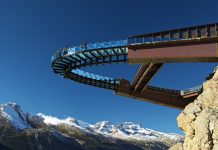 This Phoenician city, where a triad of deities was worshipped, was known as Heliopolis during the Hellenistic period. It retained its religious function during Roman times, when the sanctuary of the Heliopolitan Jupiter attracted thousands of pilgrims. Baalbek, with its colossal structures, is one of the finest examples of Imperial Roman architecture at its apogee.
This Phoenician city, where a triad of deities was worshipped, was known as Heliopolis during the Hellenistic period. It retained its religious function during Roman times, when the sanctuary of the Heliopolitan Jupiter attracted thousands of pilgrims. Baalbek, with its colossal structures, is one of the finest examples of Imperial Roman architecture at its apogee.
Outstanding Universal Value
The complex of temples at Baalbek is located at the foot of the south-west slope of Anti-Lebanon, bordering the fertile plain of the Bekaa at an altitude of 1150 m. The city of Baalbek reached its apogee during Roman times. Its colossal constructions built over a period of more than two centuries, make it one of the most famous sanctuaries of the Roman world and a model of Imperial Roman architecture. Pilgrims thronged to the sanctuary to venerate the three deities, known under the name of the Romanized Triad of Heliopolis, an essentially Phoenician cult (Jupiter, Venus and Mercury).
The importance of this amalgam of ruins of the Greco-Roman period with even more ancient vestiges of Phoenician tradition, are based on its outstanding artistic and architectural value. The acropolis of Baalbek comprises several temples. The Roman construction was built on top of earlier ruins which were formed into a raised plaza, formed of twenty-four monoliths, the largest weighing over 800 tons.
The Temple of Jupiter, principal temple of the Baalbek triad, was remarkable for its 20 m high columns that surrounded the cella, and the gigantic stones of its terrace. The adjacent temple dedicated to Bacchus is exceptional; it is richly and abundantly decorated and of impressive dimensions with its monumental gate sculpted with Bacchic figures. The Round Temple or Temple of Venus differs in its originality of layout as well as its refinement and harmonious forms, in a city where other sanctuaries are marked by monumental structures. The only remaining vestige of the Temple of Mercury located on Cheikh Abdallah Hill, is a stairway carved from the rock. The Odeon, located south of the acropolis in a place known as Boustan el Khan, is also part of the Baalbek site, and considered among the most spectacular archaeological sites of the Near East.
Baalbek became one of the most celebrated sanctuaries of the ancient world, progressively overlaid with colossal constructions which were built during more than two centuries. Its monumental ensemble is one of the most impressive testimonies of the Roman architecture of the imperial period.
Criterion (i): The archaeological site of Baalbek represents a religious complex of outstanding artistic value and its majestic monumental ensemble, with its exquisitely detailed stonework, is a unique artistic creation which reflects the amalgamation of Phoenician beliefs with the gods of the Greco-Roman pantheon through an amazing stylistic metamorphosis.
Criterion (iv): The monumental complex of Baalbek is an outstanding example of a Roman sanctuary and one of the most impressive testimonies to the Roman period at its apogee that displays to the full the power and wealth of the Roman Empire. It contains some of the largest Roman temples ever built, and they are among the best preserved. They reflect an extraordinary amalgamation of Roman architecture with local traditions of planning and layout.
Integrity
The serial nomination consists of the Temples of Jupiter, Bacchus, Venus and Mercury, and the Odeon – all the key attributes of the sanctuary. The entire town within the Arab walls, as well as the south-western quarter extra-muros between Boustan el Khan, the Roman works and the Mameluk mosque of Ras-al-Ain, provides the essential context for the key attributes.
For 15 years the city suffered as a result of armed conflict and the resultant lack of adequate planning controls and is still affected by urban pressures that make the setting of the sanctuary and the overall integrity of the property highly vulnerable.
Authenticity
In spite of extensive restoration in the 1960s and the 1980s, and the impact of armed conflict which brought unplanned development, the overall authenticity of the site has remained intact thanks to the efforts of national and international bodies. To safeguard the vestiges, the Directorate General of Antiquities (DGA) has carried out consolidation and restoration work on the various monuments, especially on the inside of the Qal’a site that comprises the Temples of Jupiter and Bacchus, as well as at the Boustan el Khan site. Nevertheless the authenticity of the property is highly vulnerable to changes that affect the detail of its structures and the overall majesty of its setting.
Protection and management requirements
Conservation and management of the property are ensured by the DGA which controls all construction and restoration permits. The Law on Antiquities No 166/1933 provides for several important protection measures for the ruins located within the protected area. Cooperation between the Directorate General for Urban Planning and the DGA facilitates expropriation concerning the land surrounding the archaeological area.
A protection and enhancement plan which is under preparation, aims at ensuring an improved presentation of these unique vestiges and the development of a new protection system for the site that respects international charts. Cooperation with specialists for the restoration of historical monuments is essential. The plan must also treat the question of improved coordination methods between the different bodies involved in the property.
Another master plan for the city, under consideration, is aimed at protecting the surrounds of the site and controlling urban development that threatens the archaeological site, the urban zone located within the Arab walls, as well as the south-west quarter (extra-muros) located between Boustan el Khan and the Roman quarry (Hajjar el Hubla).
____________________________________________________
Easier travel thanks to The Wanderlure – UNESCO World Heritage Centre – about CC licensing

















